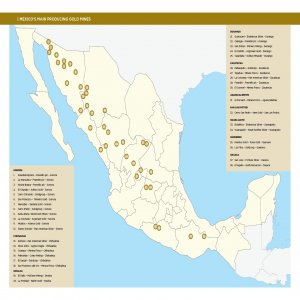Canada Remains Ally and Supporter of Mexican Mining

STORY INLINE POST
Q: What is your main advice for Canadian companies and your partners in the Mexican mining industry on how to proceed in these challenging times?
A: Unfortunately, there is not much we can do about metal prices but our key message has been to drive the competitiveness of the Mexican mining environment to attract investment. We have been working on a few key areas to do this. The first of these was the Fiscal Reform as we were very active last year to try and avoid excessive taxes. We did not seek to avoid a tax altogether but we believe the tax imposed was higher than it should have been, especially given the poor current conditions of the global mining market. We are now working with authorities to develop practices that will allow companies to prosper within the current tax environment. This involves precise strategic planning, looking at options such as tax deductions, and coming up with a financial setting that will allow companies to move forward. The real success of the Mining Task Force has been its collaboration with the key players and right authorities in the government across the mining sector. This has created a stronger voice for Canadian investors within the Mexican mining industry.
Q: How have these talks with potential partners and allies been successful?
A: During the Fiscal Reform, we believe that the mining sector was not heard and the fallout on the industry has been worse than expected. We have definitely seen a decrease in investment in Mexico and other Latin American countries over the past few years. The statistics have brought awareness within financial and governmental institutions, and we believe that they are now conscious that we were not simply complaining in order to avoid taxes, but the imposed taxes on the industry were the wrong amount at the wrong time. We have received a lot of support from federal and state governments. There are strong indications that the secondary laws and the implementation of the Fiscal Reform will bring incentives and breaks that will encourage ongoing investment in the mining sector. This means we are getting closer to a possible solution. Some steps that could be taken include deductions of exploration costs and social expenses. Ultimately, the government realizes the mining sector needs a break and has indicated a willingness to find a solution. It was unfortunate that we had to go through some tough times to get to this point as this could have been prevented with a more competitive tax percentage from the outset.
Q: How do you think Canadian foreign investment into Mexico will develop in the future?
A: Access to funds has dropped worldwide but mining is a cyclical industry. While it is dropping now, it will go back up again at some point and we already saw some improvements through 2014. Funds will continue to be raised on the TSX as it is by far the world leader for raising capital for the mining industry. Canadian investment will continue to be important on the global mining stage. As for Mexico, once we obtain more clarity as to how the new laws will be applied and once stability returns to the market, the country will start to recover the levels of participation of Canadian investment it has seen in the past. Through 2013 and the first half of 2014, Peru and Chile took over some of the market share, but once the secondary application of the Fiscal Reform is clarified, I believe Mexico will return to its leading position for attracting mining investment in Latin America. The Energy Reform will also help to clarify the Mexican legal environment. I am not certain how quickly this will happen though and an adjustment period will be needed. Despite this downturn, it is important to note that we have not seen any Canadian company in production pull out of Mexico. Every company has a different strategy but, in general, the uncertainty has led to a cutback on exploration but not a shut-down of production. Some companies have decided to hold back on investments while others are still actively participating; nobody has announced any big new projects though. Companies are in a holding period and it is unlikely we will see any major movement until legal certainty is attained.
Q: Besides big mining companies, smaller Canadian suppliers participate in every aspect of the supply chain. Have you seen less activity in Mexico on their part?
A: I have not seen less activity. Suppliers are a very important part of the value chain and play an important role in the competitiveness of mining companies. The Mining Task Force is working closely with the Canadian federal government and provincial governments to promote Canadian technologies and suppliers. We organized a big supplier event in Hermosillo in October 2014, jointly with the Province of Ontario and the Canadian Embassy in Mexico, and we are planning to continue with this promotion at major events throughout 2015. Technology can have a major impact on exploration and production costs and we believe this is an area we should be focusing on.
Q: Another concern that mining companies have voiced is insecurity. How has the Mining Task Force been helping Canadian companies to deal with this challenge?
A: Security remains a big issue, especially given the remote nature of the areas our mining companies are operating in. There are high associated costs of security spending and this obviously impacts the competitiveness of mining companies. Every company’s project is different, due to being in different areas of Mexico and having different levels of access to the sites. So while the plan for each project varies, the Mining Task Force has a security committee which shares a series of best practices and also communicates the relevant experiences of different members. Security is high on the agenda in our discussions with governmental authorities both at the federal and state levels. However, it is more important to ensure support at the local level and to encourage companies to share information and employ best practices.
Q: What are your predictions for the state of the Mexican mining industry toward the end of President Peña Nieto’s term in office?
A: I would prefer to speak of hopes and desires rather than predictions. If you were to ask me what I would like to see at the end of this presidential mandate, it would be a level of Canadian investment in the mining sector on par with, or superior to, the investment levels we saw in 2012. These were not only record levels of investment but they marked Mexico as the clearly preferred destination for investment dollars within Latin America. This will obviously depend somewhat on metal prices but Mexico’s challenge will be convincing the investment community that legal certainty and rule of law are guaranteed here.
Q: What are the goals you have yet to fulfill as President of the MTF, and how will you achieve them?
A: As President of the MTF, I would like to see a more united mining sector from investors all the way through to legislators and local communities. We have made strong inroads in adding the perspectives of the international investors to the equation, but I would like to see a better understanding between investors and legislators in terms of the social and economic impact they have in local communities. We will continue to work with our member companies, investors, legislators, and relevant government entities in order to create better understanding.





















